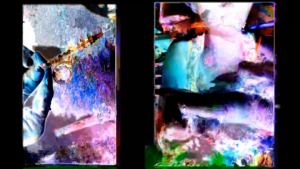May… Well first of 98% of the editing of Drug Porn is complete. Enough for a first official festival’s submission to be sent and the luxury of sharing here, today, official stills from the film. What’s left is the recording of the soundtrack, which is no small aspect, and final exporting. I hope to have a little teaser by the end of July.
Thoughts in bulk from the final laps of the editing marathon:
The artistic possibilities of glitch are swallowed by the social media bullshit of applying errors to virally relevant images. I hope I can do a little something to slowing this delegitimizing process. Because it’s more than just hoping an alteration will be pretty. It’s sculpting and twisting and torturing until the meaning of it changes completely and possibilities beyond the mathematical logic of the files are breached. For instance, ghost sounds were discovered in the video files I’ve baked that were initially silent. There’s an eeriness generated from the mutilation of the image that’s absolutely hypnotizing, especially with that type of material. Disembodied head moving towards the camera to say goodbye interspersed with fraction of bodies absorbing drugs, all synecdoche of substance entering flesh just like regular pornography since the smoke seems as solid as the needle or the dildo. It’s not the lukewarm self-preservation of “say perhaps to drugs” but pure tragic romance and literal love in certain cases. It’s more often softcore erotica than hardcore pornography. And the camera switches from a first-person view to a third so sometimes it’s self-documentation but a second later it’s really direct one-to-millions communication.
All in all it’s as, if not more (in my own opinion), relevant than chemical alteration of celluloid. It may be cheaper in material cost to work digitally but the time required to dig beyond and master it is extraordinary. Because there’s no fetish and it’s not in vogue, so you cannot be satisfied because it’s celluloid. You should never be satisfied anyway, but let’s say it’s satisfactory for the administrator of art.
I made this because I needed to make a film on this subject and I had no money to shoot the scripts I wrote. I just can’t stop even though interest in my stuff is understandably limited. But this 2-year long process of archiving and manipulating was way more grueling than shooting ANA. 2019, I’m making this gore film I always dreamt of making.
Lamentation aside, I’ve finally digitally released the new Un regard froid album Palinodie (Anticinéma) and the music video for Un à un (De bruit et de fureur). Physical objects will be released later this year, but I had a personal obligation to have it out in the open on June 1st. So that’s that. The lyrics are extremely personal and inspired by films that left a huge impact on my current state of mind. I spent a lot of time focusing on the vocals and the rhythmic dimension, something I found lacking in my past releases. It is about hate but also about “saying yes to life” in all its decadence and aberration, an expression I’m stealing from Michel Surya biography of Georges Bataille.
I’m also quite happy my little short film Code > <-Virus received some positive festival presence in May. It was screened in Berlin at Fracto Experimental Film Encounter, in Bogota at Cineautopsia and at Montreal Underground Film Festival.
Except if anything noteworthy is happening, I won’t make any update this summer. I intend to work on a new paper collage series, plow through the books of Nick Land and CCRU, go through my media backlog and drink some wine.
Stuff I enjoyed in May:
Lingua Ignota – All Bitches Die
Architecture of Doom
Cosmic Void Ritual – Vitriol Tablet Instructions: Rehearsing Speeches For When You Die
The Rita – Choreography to Cracked Linear Textural Sound
Like Me
Island Of Death
Blackhandpath – Did It and Got Away With It
Vessel of Iniquity – Self-titled
Sect Pig – Crooked Backs
The work of Alexander Brodsky & Ilya Utkin
RIP Adam Parfrey
RIP Scooby “Monsieur” Doux.
L’art a une affinité particulière avec les pathologies de son époque; c’est là aussi la raison du lien entre les dimensions de l’expression et de l’évaluation, de l’esthétique et du thérapeutique. La signification qui n’est pas encore publiquement reconnue apparaît elle-même sous les traits d’une réalité pathologique, jusqu’à ce qu’elle soit intégrée au langage commun. Identifié à la pathologie qu’il met ne évidence, l’artiste novateur apparaît d’abord comme un malade, un pervers, un être déviant, un provocateur. C’est, dès lors, chaque fois une cécité particulière des langages communs qui est visée par une œuvre d’art novatrice.
Aussi loin que l’on remonte dans l’histoire des temps modernes, les grands mouvements d’innovation artistique ont été perçus comme des menaces pathologiques, avant de devenir les piliers de l’académisme au nom duquel on pouvait condamner les innovations suivantes.
– Rainer Rochlitz (Subversion et subvention)





